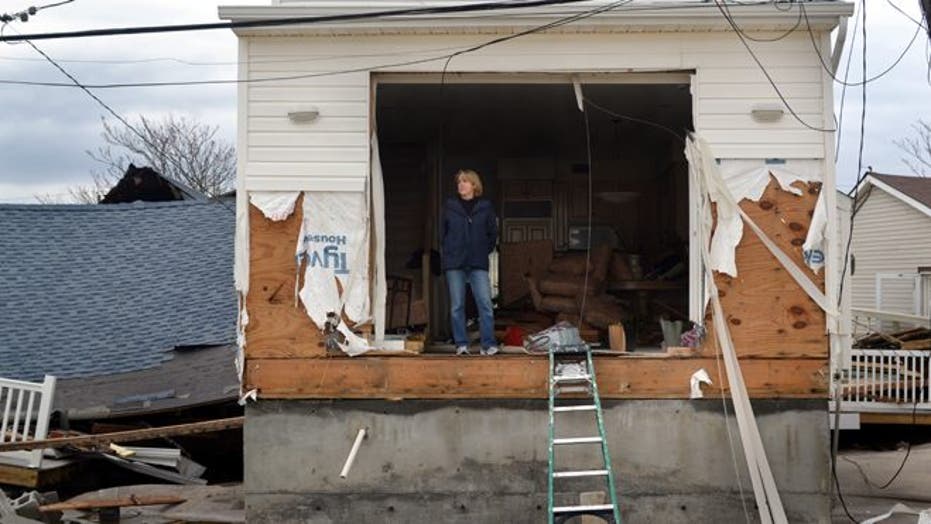Breezy Point, NY – Tom Tully had a blank stare as he shuffled across a strip of concrete covered with sand. It was what little was left of his home.
The 62-year old bartender has spent his entire life in this New York City beach community and has weathered a wide variety of storms, from Hurricane Donna to Tropical Storm Irene. But nothing could have prepared him for what happened when Sandy came barreling through Monday night. A 14-foot storm surge flooded his home and sent his back deck flying 50 yards away.
All that remained of his family’s home is a sagging shell littered with debris and family mementos.
“It’s a lot to take in in one shot,” an emotional Tully said as he picked through the rubble scattered about in an attempt to salvage anything he could, from tools to golf clubs.
“You just kind of glaze over because it’s just like 'Woo, what happened?'”
Located on the southernmost edge of New York’s Rockaway Peninsula, Breezy Point was one of the community’s hardest hit by Hurricane Sandy. Like thousands of others, Tully, along with his brother, Gene, on Wednesday began the difficult task of picking up the fragments of his broken home and trying to put a life back together, piece by piece, for himself and his family.
As the two worked toward rebuilding, friends and neighbors approached to discuss the disaster and check in.
We’re going to rebuild. We’ve been here since the fifties and we’re not going anywhere.
“We’re going to rebuild. We’ve been here since the 50s and we’re not going anywhere,” said Gene Tully. “Breezy Point is a pretty resilient community.”
Less than a quarter mile south of Tully’s home, on the same sandy strip, 111 homes were destroyed and 20 more damaged when a six-alarm fire broke out on Oceanside Avenue during the height of the storm.
“It’s hard to think that everything is gone,” said Louise Duffy, 20, whose home was among those destroyed in the blaze. “I’m upset, there’s nothing left.”
Officials said the fire was reported around 11 p.m. Monday in an area flooded by the superstorm. Video footage of the scene showed a swath of tightly packed homes engulfed in orange flames as firefighters hauled hoses while sloshing in ankle-high water.
Homes in Breezy Point that weren’t flattened by the fire are in only slightly better shape. Entire front facades were torn off homes, family portraits buried in mounds of sand, clothes and mattresses bob in water. The stench of fetid standing water and burnt wood fill the air.
“You try to bear in mind that it’s just stuff and then later down the road you’ll be missing pictures of this or that,” Tully said. “But that everybody is safe is number one.”
New York Gov. Andrew Cuomo toured the beach community on Wednesday, where he promised that the state would help in the rebuilding of Breezy Point. One of the houses destroyed in the storm was the home of U.S. Rep. Bob Turner (R-Queens), who said he was relieved that he and his family were safe after the storm.
As of Wednesday night, much of the New York metropolitan area was still feeling the effects of Sandy. In New Jersey 2.1 million people are still without power and over 250,000 people were still in the dark in Lower Manhattan alone.
At least 74 people have been killed by the storm, with numbers expected to rise as search-and-rescue operations continue. Thirty people have been reported dead in New York state alone, with two toddlers being reportedly killed after they were swept from their mother’s arms on a flooded street in Staten Island.
Despite the destruction and fire, none of Sandy’s victims came from Breezy Point…a fact that Tully and other area residents don’t take lightly.
“I’m relieved that no one was hurt," Gene Tully said. "There are just so many people that got hammered by it."
For the Tully family and the other residents of Breezy Point, the next few days will be spent cleaning up, trying to salvage what little they can and hoping that FEMA and their insurance companies provide them with the support they need to rebuild. Along the ocean-front properties, despite the devastation, residents appeared upbeat and resigned to get the clean-up started. But they were also somber about what happened.
While comparisons were drawn to World War II and Afghanistan by some, the shellshock appeared to be replaced by cautious optimism.
“We’ll get back on our feet, we’re all good people,” Tully said. “We’ve always pulled together for other people when they needed it. So now it’s our turn.”

